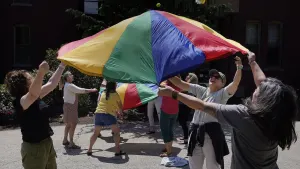More Stories
If you are caring for someone with COVID-19 at home, the U.S. Centers for Disease Control and Prevention has some tips on what to do when someone has symptoms of the coronavirus, or when someone has been diagnosed with the virus.
This information should also be followed when caring for people who have tested positive, but are not showing symptoms.
Provide support and help cover basic needs
1. Help the person who is sick follow their doctor’s instructions for care and medicine.
2. See if over-the-counter medicines for fever help the person feel better.
3. Make sure the person who is sick drinks a lot of fluids and rests.
4. Help them with grocery shopping, filling prescriptions, and getting other items they may need. Consider having the items delivered through a delivery service, if possible.
5. Take care of their pet(s), and limit contact between the person who is sick and their pet(s) when possible.
Watch for warning signs
6. Have their doctor’s phone number on hand.
7. Use CDC’s self-checker tool to help you make decisions about seeking appropriate medical care.
8. Call their doctor if the person keeps getting sicker. For medical emergencies, call 911 and tell the dispatcher that the person has or might have COVID-19.
Protect yourself
9. COVID-19 spreads between people who are in close contact (within about 6 feet) through respiratory droplets, created when someone talks, coughs or sneezes. Staying away from others helps stop the spread of COVID-19.
10. The caregiver, when possible, should not be someone who is at higher risk for severe illness from COVID-19.
11. The sick person should separate themselves from others in the home, and use a separate bedroom and bathroom.
12. Avoid having any unnecessary visitors, especially visits by people who are at higher risk for severe illness.
13. Caregivers and anyone who has been in close contact with someone who has COVID-19 should stay home.
Eat in separate rooms or areas
14. The person who is sick should eat (or be fed) in their room, if possible.
15. Handle any dishes, cups/glasses, or silverware used by the person who is sick with gloves. Wash them with soap and hot water or in a dishwasher.
16. Clean hands after taking off gloves or handling used items.
17. Do not share dishes, cups, glasses, silverware, towels, bedding, or electronics (like a cellphone) with the person who is sick.
When to wear a mask or gloves
18. The person who is sick should wear a mask when they are around other people at home and out (including at a doctor’s office).
19. The caregiver may also wear a mask when caring for a person who is sick.
To prevent getting sick, make sure you practice everyday preventive actions: clean hands often; avoid touching your eyes, nose, and mouth with unwashed hands; and frequently clean and disinfect surfaces.
20. Wear gloves when you touch or have contact with the sick person’s blood, stool, or body fluids, such as saliva, mucus, vomit, and urine. Throw out gloves into a lined trash can and wash hands right away.
Clean your hands often
21. Wash your hands often with soap and water for at least 20 seconds. Tell everyone in the home to do the same, especially after being near the person who is sick.
22. If soap and water are not readily available, use a hand sanitizer that contains at least 60% alcohol. Cover all surfaces of your hands and rub them together until they feel dry.
23. Avoid touching your eyes, nose, and mouth with unwashed hands.
Clean and then disinfect
24. Clean and disinfect high-touch surfaces and items every day, this includes tables, doorknobs, light switches, handles, desks, toilets, faucets, sinks, and electronics.
25. Clean the area or item with soap and water if it is dirty. Then, use a household disinfectant.
26. To clean electronics, follow the manufacturer’s instructions for all cleaning and disinfection products. If those directions are not available, use alcohol-based wipes or spray containing at least 70% alcohol.
27. If you are using a separate bedroom and bathroom, only clean the area around the person who is sick when needed, such as when the area is soiled. This will help limit your contact with the sick person. If they feel up to it, the person who is sick can clean their own space. Give the person who is sick personal cleaning supplies such as tissues, paper towels, cleaners, and EPA-registered disinfectants.
28. If sharing a bathroom, the person who is sick should clean and then disinfect after each use. If this is not possible, wear a mask and wait as long as possible after the sick person has used the bathroom before coming in to clean and use it.
Wash and dry laundry
29. Do not shake dirty laundry.
30. Wear disposable gloves while handling dirty laundry.
31. Dirty laundry from a person who is sick can be washed with other people’s items.
32. Wash items according to the label instructions. Use the warmest water setting you can.
33. Remove gloves, and wash hands right away.
34. Dry laundry, on hot if possible, completely.
35. Wash hands after putting clothes in the dryer.
36. Clean and disinfect clothes hampers. Wash hands afterward.
Use lined trash can
37. Place used disposable gloves and other contaminated items in a lined trash can.
38. Use gloves when removing garbage bags, and handling and disposing of trash. Wash hands afterward.
39. Place all used disposable gloves, masks, and other contaminated items in a lined trash can.
40. If possible, dedicate a lined trash can for the person who is sick.
Track your own health
41. Caregivers should stay home and monitor their health for COVID-19 symptoms while caring for the person who is sick. Symptoms include fever, cough, and shortness of breath but other symptoms may be present as well. Trouble breathing is a more serious warning sign that you need medical attention.
42. Caregivers should continue to stay home after care is complete. Caregivers can leave their home 14 days after their last close contact with the person who is sick (based on the time it takes to develop illness), or 14 days after the person who is sick meets the criteria to end home isolation.
More from News 12
1:28

5 simple steps for long-term benefits to your health and heart
1:32

8 tips for working safely during hot weather
3:31

Guide: Ways to set your child up for financial success
3:18

Guide: The importance of good sleep and how to get it

Guide: Mental health resources available in the tri-state
9:36
